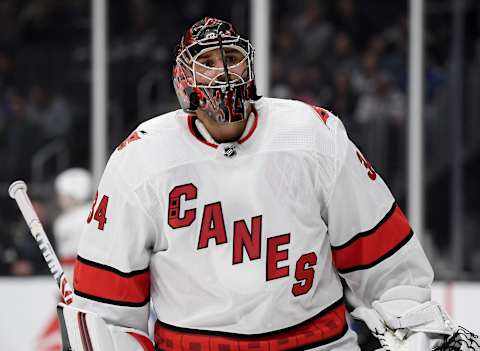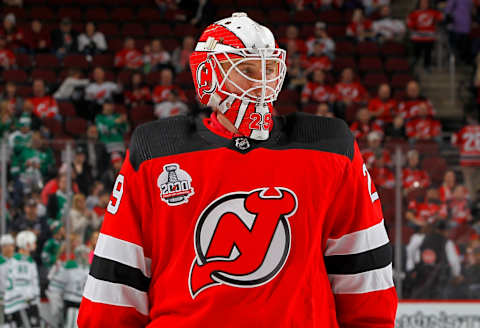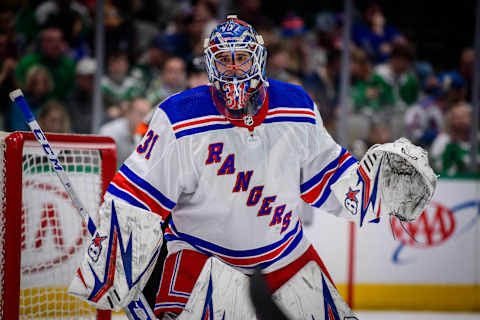NHL: Ranking the starting goaltenders of the Metropolitan Division


The NHL’s Metropolitan Division is loaded with goaltending talent from top to bottom.
More often than not, a team will rise and fall with the play of their starting goaltender. Each division has a unique blend of goaltenders, with some divisions having large disparities in their netminders’ talent, while others are evenly matched.
At the pause of the 2019-20 season, the Metropolitan Division featured seven teams in playoff contention. The Washington Capitals were the cream of the crop with 90 points, while the seventh-seeded New York Rangers sat just two points back of the final wild-card spot. A large reason for the divisional depth was the goaltending depth that each team possessed.
Ranking the Metropolitan Division’s goaltenders is not an easy task. No matter the list I put together, I will be slighting a goalie who would likely be higher had they played in a different division. To assist my decision making, I am utilizing these statistical categories as well as the eye test.
- GAA (Goals Against Average)
- SV% (Save Percentage)
- QS% (Quality Start Percentage)
- GSAA (Goals Saved Above Average)
- RBS (Really Bad Starts)
- HDSV% (High Danger Save Percentage)
- HDGAA (High Danger Goals Against Average)
With the parameters being set, let’s get to it.
Petr Mrazek. 8. player. 109. . .
Petr Mrazek’s numbers will never dazzle you, but he has given the Hurricanes reliable goaltending, especially when they need it the most. The 28-year old posted a 21-16-2 record last season with a GAA of 2.69 and a .905 SV%. Those numbers, albeit not terrible, were by far the most lackluster out of the Metro’s goaltending crop.
Mrazek had a 50 QS%, seven RBS, and an abysmal -5.35 GSAA. Basically, the Hurricanes netminder was not stealing games for his squad last season, something Carolina hopes to see him do more in 2021.
His high danger numbers were steady, posting an HDGAA of 1.50 and an HDSV% of .820. Despite that, Mrazek still has a lot of work to do to move up this list, but the Hurricanes are loaded, so he will have plenty of help in doing so.

. Ilya Samsonov. 7. player. 19. .
Ilya Samsonov was a wild card on this list, as his solid numbers could have moved him as high as five. Instead, he comes in at seven, predominately due to his lack of a track record, despite his numbers being eerily similar to the two men in front of him.
Samsonov finished 2019-20 with a 16-6-2 record, with a 2.55 GAA and a .913 SV%. He had a QS% of 59.1, minimizing his RBS to just 2. His play needed to be solid and not outstanding for the Capitals to get to where they wanted to go, and his 2.30 GSAA, .795 HDSV%, and 1.62 HDGAA dictate that.
At just 23-years old, Samsonov will have the ability to take the starting reigns full time in 2021, a season that will truly show us if he is a legitimate number one or still needs time to qualify as such.
Semyon Varlamov. 6. player. 106. . .
Semyon Varlamov was rarely called upon to be exceptional due to the Islanders’ defensive structure, but he was reliable, stopping everything needed of him. He put together a nice record of 19-14-6 to go along with a 2.62 GAA and a .914 SV%.
His QS% was slightly above the league average of 53% at 53.8%, replicating his sturdy presence amidst the Islanders’ phenomenal defense. Four of his starts qualified as RBS, but his GSAA of 5.56 placed him ahead of his Metropolitan Division foes Hart and Korpisalo.

Varlamov possessed a .812 HDSV% and a 1.56 HDGAA, demonstrating his ability to stop the necessary shots from winning. The veteran’s presence in the net is not overwhelming, but he is the perfect netminder for the Isles, grooming Ilya Sorokin to be his replacement.

. . . Joonas Korpisalo. 5. player. 113
Faced with injury, Joonas Korpisalo’s regular season was solid, but his true emergence came in front of everyone’s eyes in the postseason. Yet, the goaltending’s depth in this division combined with his regular-season numbers leaves him fifth on this list.
A 19-12-5 record, 2.60 GAA, and a .911 SV% will not leap off the page at you, but a QS% of 60 will. Korpisalo managed a mere 1.14 GSAA (7.91 in the postseason), a number which was surely detrimental to his spot on these rankings. Additionally, he had 5 RBS, but his high danger numbers were nothing to sneeze at.
With an HDSV% of .812 and an HDGAA of 1.38, Korpisalo showed glimpses of his postseason breakout but failed to sustain that level of play. If Korpisalo’s postseason play can carry over to 2021, he won’t be fifth on this list much longer.
. . . Mackenzie Blackwood. 4. player. 85
Mackenzie Blackwood is one of the rising young goaltenders in the NHL and will continue his uptick in production next season. Under the tutelage of veteran Corey Crawford, Blackwood should reduce his workload and play at an even higher level.
He finished the 2019-20 season with a 22-14-8 record, a 2.77 GAA, and a .915 SV%. At times, his play and the play of his defense would turn erratic, leading to a 51.2 QS%, which falls below league average. That combination would lead to six RBS, but Blackwood’s skill alone allowed him to own a 7.29 GSAA.
High danger situations unleashed just how talented Blackwood can be, as he put up an astounding 1.25 HDGAA and a .838 HDSV%. Blackwood is a rising young goaltender in this league whose presence will be felt in the Metro.

95. . . . Igor Shesterkin. 3. player
Igor Shesterkin suited up for his first game in January with the highest expectations and immediately shattered them, winning 10 of his 12 starts. Had he not suffered fractured ribs in an unfortunate car accident, he may have thrust his name into the Calder conversation.
Shesterkin finished his first 12 NHL games with a GAA of 2.52, a .932 SV%, and one RBS. Amazingly he recorded a QS% of 75, trailing only Darcey Kuemper (greater than 5 GP) and a GSAA of 9.34 despite playing so few games. With an amazing HDSV% of .849 and a solid HDGAA of 1.56, Shesterkin would clearly have rivaled the two netminders in front of him in a full season.
At 24-years old, the Russian netminder has a wealth of experience at the KHL and international levels that allow an accurate picture of his ability despite his limited NHL experience. If Shesterkin’s history of success holds up in 2021, it will come as a shock to none if he is viewed as the Metropolitan Division’s best goaltender at the season’s end.
. . . Tristian Jarry. 2. player. 92
Taking over the starting job from two-time Stanley Cup Champion Matt Murray, Jarry quietly pieced together an All-Star 2019-20 season. Racking up a 20-12-1 record with a superb .921 SV% and 2.43 GAA, Jarry helped get the inconsistent Penguins into the Qualifying Round as a fifth-seed.
The reason Jarry failed to surpass Hart for the top spot is due to his poor high-danger numbers. He ranked 49th with an HDSV% of .805 and 30th in HDGAA with a 1.46, both well behind Hart. Jarry didn’t stop as many high-danger chances as his cross-state rival, but he did have a higher GSAA at 11.07 and a similar QS% at 61.3.
Jarry took his first opportunity at the NHL level and ran with it, making his former teammate Murray an expendable piece. Part of that run included a minuscule total of just 3 RBS in 31 starts, a number that dictates just how consistent Jarry was all season for Pittsburgh.
1. player. 68. . . . Carter Hart
At 22-years of age, Carter Hart has already established himself as a legitimate number one goaltender in the NHL. It would seem obvious putting him as the number one goalie in the division, but he just barely claimed the first spot by a slim 4-3 statistical margin over the number two ranked netminder.
Hart was an impressive 24-13-3 in 2019-20, backstopping the Flyers to the second spot in the division. He had a 2.42 GAA and a .914 SV% to go along with 9 RBS but really was impressive when diving into the advanced analytics. His GSAA was a mediocre 4.46, but a 62.5 QS% ranked 13 amongst the league goaltenders.
He owned an impressive .820 HDSV% as well as a very solid 1.32 HDGAA, per Natural Stat Trick, each finishing higher than the number two ranked Tristian Jarry. Overall, Hart was excellent in every aspect of the position, playing well above his age throughout his 40 starts.